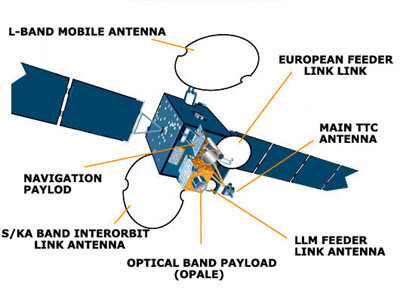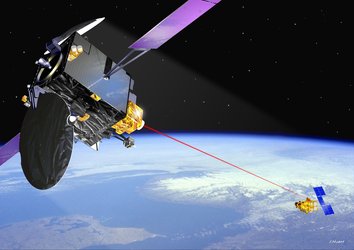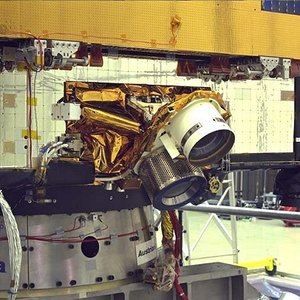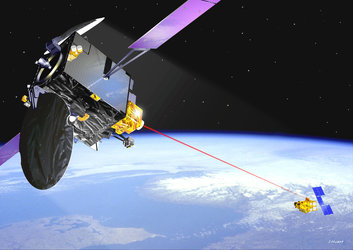Artemis finally on course for ground-breaking mission
An experimental ion propulsion system designed to test a new form of technology for station-keeping on future satellites has ended up in a new role that should save the day for ESA's Artemis spacecraft manufactured by Alenia Spazio as Prime Contractor.
Ion engines have the potential for being 10 times more efficient than chemical engines and were conceived as a possible alternative for the crucial task of maintaining a satellite’s orbital position.
But after launch by an Ariane 5 in summer 2001, the Artemis (Advanced Relay and TEchnology MISsion) spacecraft was left in a far lower than intended orbit, with insufficient conventional propellant to even just raise it to its nominal orbit.
“The launch malfunction left Artemis in a degraded orbit and if chemical propellant had been the only form of thrust available, the satellite would never make it to geostationary orbit and be unable to start its exciting mission,” said Gotthard Oppenhauser, ESA’s Artemis Project Manager.
“Fortunately, adapting the use of the ion propulsion system combined with daring unconventional operations of the chemical-based thrusters, have offered a way of reaching the required orbit,” he explained.
“The spacecraft has demonstrated itself to be robust and flexible enough to allow manoeuvres largely out of the specified requirements” said Fabio Palamidessi, Alena Spazio’s Artemis Programme Manager. “This was the prerequiste for the decision to proceed with a massive recovery activity”, he continued.
Within days of the launch in July 2001 an industry team of Alenia, Astrium and Telespazio, supported by ESA engineers, worked out a solution that used conventional propellant to place the spacecraft into a safe parking orbit at 31,000 km altitude.
“This initial quick response – only possible with the conventional chemical system – complemented by continuous operation of the ion engines, will eventually enable Artemis to perform most of its nominal mission,” added Mr Oppenhauser.
Then the team undertook the challenging task to develop, test and implement new in-flight software and control strategies using electric propulsion to complete the orbit raising. The newly designed system now enables the spacecraft to turn away from the Earth, using precision sun sensors and gyroscopes to navigate its way to geostationary orbit.
“Ion propulsion has been given the perfect opportunity to prove itself and we are hoping, despite the obvious fuel limitations, that it will be able to keep Artemis ‘alive’ for as near to its originally planned lifetime as possible,” said Mr Oppenhauser.
The Director General of Italy’s Telespazio, Mr Sabatino Stornelli, explained: “after more than six months of intense preparation and testing, the operations of the spacecraft in the new control modes have been tuned to perfection.
“The team here in Italy now have the crucial role of implementing a clever sequence of firing a pair of ion engines, aimed at Artemis arriving at its nominal altitude with zero inclination by the end of this summer.

“In retrospect, Artemis could prove to be a very effective demonstration of how ion propulsion can give more flexibility and reliability to future space missions,” he added. Propelled by the thrust from the ion propulsion system, Artemis is now set to ‘spiral’ towards its nominal geostationary location, increasing altitude at a rate of about one kilometre an hour.
The satellite’s various technology payloads can then begin offering new services in the fields of advanced mobile communications systems and navigation.
In addition to a conventional radio frequency data relay payload developed by Alenia Spazio, Artemis is equipped with a laser communications link (SILEX) developed by Astrium France, which is a world first for satellite-to-satellite communications.
Already, the first communication links with SPOT 4, the French Earth observation satellite, have been established successfully with SILEX. Once Artemis becomes fully operational, it will be able to receive data from Spot 4 via the laser link and transmit it straight to a ground base in Toulouse.
When ESA’s Envisat – the largest and most sophisticated Earth observation satellite ever built – is launched on 28 February, it will also use Artemis as one of its communication links to relay data from its 10 instruments to scientists on the ground.









